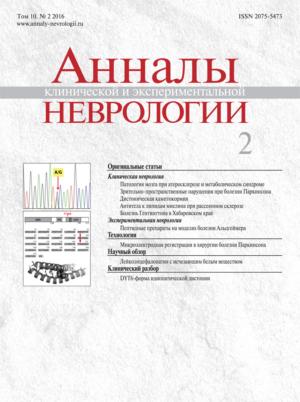Микроэлектродная регистрация нейрональной активности в хирургии болезни Паркинсона
- Авторы: Низаметдинова Д.M.1, Тюрников В.М.1, Федоренко И.И.1, Гуща А.О.1, Иллариошкин С.Н.1
-
Учреждения:
- ФГБНУ «Научный центр неврологии»
- Выпуск: Том 10, № 2 (2016)
- Страницы: 42-45
- Раздел: Технологии
- Дата подачи: 31.01.2017
- Дата публикации: 03.02.2017
- URL: https://annaly-nevrologii.com/journal/pathID/article/view/60
- DOI: https://doi.org/10.17816/psaic60
- ID: 60
Цитировать
Полный текст
Аннотация
Микроэлектродная регистрация нейрональной активности – современный и безопасный инструмент нейрофизиологического картирования подкорковых структур головного мозга, служащих мишенями стереотаксической функциональной нейрохирургии. В статье рассматриваются основные технические и клинические аспекты применения данного метода. Микроэлектродный анализ повышает точность позиционирования электрода и эффективность хирургической нейромодуляции при болезни Паркинсона, позволяет изучать патофизиологические особенности экстрапирамидных заболеваний, механизмы действия лекарственных препаратов и различных технологий функциональной нейрохирургии, а также способствует поиску новых потенциальных мишеней для глубокой стимуляции мозга.
Об авторах
Д. M. Низаметдинова
ФГБНУ «Научный центр неврологии»
Автор, ответственный за переписку.
Email: dinara.dinara@mail.ru
Россия, Москва
Владимир Михайлович Тюрников
ФГБНУ «Научный центр неврологии»
Email: dinara.dinara@mail.ru
Россия, Москва
И. И. Федоренко
ФГБНУ «Научный центр неврологии»
Email: dinara.dinara@mail.ru
Россия, Москва
Артем Олегович Гуща
ФГБНУ «Научный центр неврологии»
Email: dinara.dinara@mail.ru
Россия, Москва
Сергей Николаевич Иллариошкин
ФГБНУ «Научный центр неврологии»
Email: dinara.dinara@mail.ru
ORCID iD: 0000-0002-2704-6282
д.м.н., проф., член-корр. РАН, зам. директора по научной работе, рук. отдела исследований мозга
Россия, МоскваСписок литературы
- Иллариошкин С.Н. Терапия паркинсонизма: возможности и перспективы. Неврология и ревматология. Приложение к журналу Consilium Medicum. 2009; 1: 35–40.
- Седов А.С., Медведник А.Р., Раева С.Н. Значение локальной синхронизации и осцилляторной активности нейронов таламуса в целенаправленной деятельности человека. Физиология человека. 2014; 1: 5–12.
- Abosch A., Hutchison W.D., Saint-Cyr J.A. et al. Movement-related neurons of the subthalamic nucleus in patients with Parkinson disease. J. Neurosurg. 2002; 97: 1167–1172.
- Bain P., Aziz T., Liu X. et al. Deep Brain Stimulation. Oxford, UK: Oxford University Press, 2009.
- Ben Haim S., Asaad W.F., Gale J.T., Eskandar E.N. Risk factors for hemorrhage during microelectrode-guided deep brain stimulation and the introduction of an improved microelectrode design. Neurosurgery.2009; 64: 754–762.
- Benabid A.L., Koudsie A., Benazzouz A. et al. Deep brain stimulation for Parkinson’s disease. Adv. Neurol. 2001; 86: 405–412.
- Bergman H., Wichmann T., Karmon B., De Long M.R. The primate subthalamic nucleus. II. Neuronal activity in the MPTP model of parkinsonism J. Neurophysiol. 1994; 72: 507–520.
- Binder D.K., Rau G.M., Starr P.A. Risk factors for hemorrhage during microelectrode-guided deep brain stimulator implantation for movement disorders. Neurosurgery. 2005; 56: 722–732.
- Castrioto A., Moro E. New targets for deep brain stimulation treatment of Parkinson’s disease. Expert Rev. Neurother. 2013; 13: 1319–1328.
- Deletis V., Shils J.L. (ed.) Neurophysiology in neurosurgery. A modern intraoperative approach. San Diego: Academic press, 2002.
- Feng H., Zhuang P., Hallett M. et al. Characteristics of subthalamic oscillatory activity in parkinsonian akinetic-rigid type and mixed type. Int. J. Neurosci. 2015; 20: 1–10.
- Gross R.E., Krack P., Rodriguez-Oroz M.C. et al. Electrophysiological mapping for the implantation of deep brain stimulators for Parkinson’s disease and tremor. Mov. Disord. 2006; 21: 259–283.
- Guo S., Zhuang P., Zheng Z. et al. Neuronal firing patterns in the subthalamic nucleus in patients with akinetic-rigid-type Parkinson’s disease. J. Clin. Neurosci. 2012; 19: 1404–1407.
- Guridi J., Rodriguez-Oroz M.C., Lozano A.M. et al. Targeting the basal ganglia for deep brain stimulation in Parkinson disease. Neurology. 2000; 55: 21–28.
- Hutchison W.D., Lang A.E., Dostrovsky J.O., Lozano A.M. Pallidal neuronal activity: implications for models of dystonia. Ann. Neurol. 2003; 53: 480–488.
- Israel Z., Burchiel K. Microelectrode recording in movement disorder surgery. New York: Thieme, 2004.
- Lozano A.M., Lang A.E., Levy R. et al. Neuronal recordings in Parkinson’s disease patients with dyskinesias induced by apomorphine. Ann. Neurol. 2000; 47: 141–146.
- Lozano A.M., Snyder B.J., Hamani C. et al. Basal ganglia physiology and deep brain stimulation. Mov. Disord. 2010; 25: 71–75.
- Stefani A., Lozano A.M., Peppe A. et al. Bilateral deep brain stimulation of the pedunculopontine and subthalamic nuclei in severe Parkinson’s disease. Brain. 2007; 130: 1596–1607.
- Vesper J., Haak S., Ostertag S. et al. Subthalamic nucleus deep brain stimulation in elderly patients – analysis of outcome and complications. BMC Neurol. 2007; 7: 7–16.
- Weinberger M., Hamani C., Hutchison W.D. Hutchison W.D et al. Pedunculopontine nucleus microelectrode recordings in movement disorder patients. Exp. Brain Res. 2008; 188: 165–174.
Дополнительные файлы








